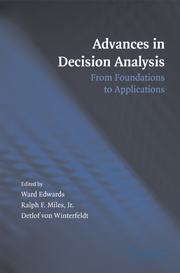Book contents
- Frontmatter
- Contents
- List of Contributors
- Preface
- 1 Introduction
- PART I HISTORY AND FOUNDATIONS OF DECISION ANALYSIS
- 2 The Emergence of Decision Analysis
- 3 The Foundations of Decision Analysis Revisited
- 4 Decision Analysis: A Personal Account of How It Got Started and Evolved
- 5 Reflections on the Contributions of Ward Edwards to Decision Analysis and Behavioral Research
- PART II STRUCTURING DECISION PROBLEMS
- PART III PROBABILITIES AND BAYES NETS
- PART IV UTILITIES
- PART V RISK ANALYSIS
- PART VI DECISION ANALYSIS IN A BEHAVIORAL AND ORGANIZATIONAL CONTEXT
- PART VII APPLICATIONS OF DECISION ANALYSIS
- Index
- References
4 - Decision Analysis: A Personal Account of How It Got Started and Evolved
Published online by Cambridge University Press: 05 June 2012
- Frontmatter
- Contents
- List of Contributors
- Preface
- 1 Introduction
- PART I HISTORY AND FOUNDATIONS OF DECISION ANALYSIS
- 2 The Emergence of Decision Analysis
- 3 The Foundations of Decision Analysis Revisited
- 4 Decision Analysis: A Personal Account of How It Got Started and Evolved
- 5 Reflections on the Contributions of Ward Edwards to Decision Analysis and Behavioral Research
- PART II STRUCTURING DECISION PROBLEMS
- PART III PROBABILITIES AND BAYES NETS
- PART IV UTILITIES
- PART V RISK ANALYSIS
- PART VI DECISION ANALYSIS IN A BEHAVIORAL AND ORGANIZATIONAL CONTEXT
- PART VII APPLICATIONS OF DECISION ANALYSIS
- Index
- References
Summary
EDITORS' NOTE. In this chapter Howard Raiffa discusses the evolution of decision analysis and his personal involvement in its development. He describes the early days of Operations Research (OR) in the late 1940s with its approach to complex, strategic decision making. After reading John von Neumann and Oskar Morgenstern's Theory of Games and Economic Behavior (1947) and Abraham Wald's two books (1947, 1950), he became involved in statistical decision theory. A few years later, after reading Leonard Savage's The Foundations of Statistics (1954), he became convinced that classical statistics was not the right approach to analysis for decision making. In 1957, with R. Duncan Luce, he published Games and Decisions (1957), which presented the theory of von Neumann and Morgenstern to a wider audience. In 1961, with Robert Schlaifer, he published Applied Statistical Decision Theory (1961) to prove that “whatever the objectivists could do, we subjectivists could also do – only better.” In 1968, he published Decision Analysis (1968), the first book on the subject, and, in 1976, he published Decisions with Multiple Objectives (1976) with Ralph Keeney. These two books laid the foundation of decision analysis as it is practiced today. His interests then tuned to negotiation, resulting in the publication of The Art and Science of Negotiation (1982) and Negotiation Analysis (2002).
- Type
- Chapter
- Information
- Advances in Decision AnalysisFrom Foundations to Applications, pp. 57 - 70Publisher: Cambridge University PressPrint publication year: 2007
References
- 1
- Cited by

